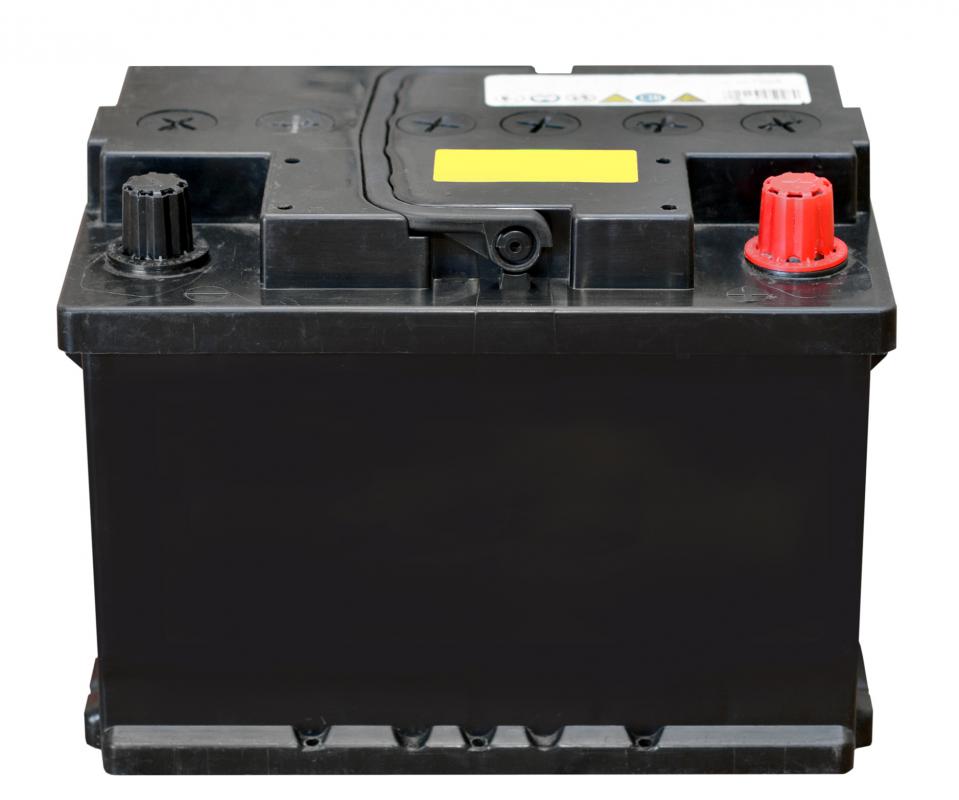At WiseGEEK, we're committed to delivering accurate, trustworthy information. Our expert-authored content is rigorously fact-checked and sourced from credible authorities. Discover how we uphold the highest standards in providing you with reliable knowledge.
What is a Lead Storage Battery?
Like all batteries, a lead storage battery uses a chemical reaction to store and generate electrical energy. Lead batteries use lead and lead oxide for the cathode and anode components of the battery and sulfuric acid for the electrolyte. These batteries are easy and inexpensive to manufacture, can provide a high peak discharge, and are rechargeable. They do not, however, hold as much energy per unit of weight as do more modern batteries. This kind of battery is widely used to power the electrical starters of motor vehicles in other applications where cost is more of a factor than weight.
All batteries employ a cathode and an anode, made of a substances that would exchange electrons with one another to reach a balanced state if not for the presence of an electrolyte solution that inhibits this transfer of electrons. When current is drawn from a battery, electrons are allowed to flow between the two poles, from the anode to the cathode, and the inhibited chemical reaction takes place. No electrolyte is able to perfectly insulate the anode and cathode, and so all batteries lose charge slowly over time. Most lead storage batteries employ multiple cells, so that the same chemical reaction takes place in each cell at the same time, a process that increases the peak discharge potential of the battery while reducing the total power it can store.

In a lead storage battery, both the anode and the cathode interact chemically with the electrolyte solution as well. In a charged battery, the anode consists of lead and the cathode of lead oxide. As the battery is discharged, both electrodes are converted to lead sulfate, as the electrolyte bath becomes less and less acidic, until only water remains in the solution. This process is reversed when a lead storage battery is charged, and at full charge, the electrolyte solution of a lead-acid battery is a highly acidic bath of one-third sulfuric acid.
This type of battery is relatively easy to manufacture, as all of the necessary materials are abundant. Due to the relatively low power to weight ratio in a lead storage battery, however, some compromises must be made in their design. Batteries designed to deliver a great deal of current, such as those used to start motor vehicles, must be made by combining many smaller battery cells with wide, thin, fragile electrodes. When power is needed over a longer period of time, lead storage batteries must contain fewer but larger and more durable cells. Such a lead storage battery would be a poor choice for starting vehicles but excellent for providing small amounts of portable power for computer backup devices or for appliances such as electric lawn mowers, which need never travel far from a power source.
AS FEATURED ON:
AS FEATURED ON:











Discussion Comments
@Vincenzo -- All batteries (even the tiny ones you use at home) are not good for the environment. They all have to be disposed of properly to avoid trouble.
The lead battery is no different. If you get rid of it like you are supposed to, then it is no better or worse for the environment than other batteries.
As for why people use them, those things are cheap and the article points that out. You might be able to get some batteries made with newer, snazzier materials but they will cost more. There are times when a cheap, reliable led battery will do just fine.
Wait a minute. I thought we were trying to get away from using lead for things. It has been demonstrated time and time again that lead is rough on the environment, is harmful to the mental development of children when it gets into the air or is ingested and all sorts of things.
Why on earth, then, would we have a lead storage battery? Safer, better materials are clearly available so I don't understand why people don't have to use them.
Post your comments